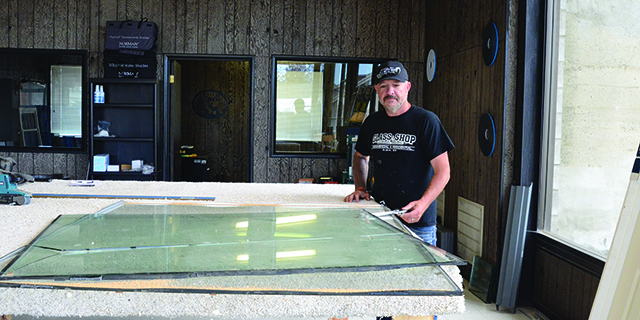COVID-19: Oregon prison system’s unwelcome death sentence
Published 4:00 am Friday, December 18, 2020

- Inmate Marquel Dugas plays with one of the puppies in the prison’s whelping program during a training session in 2019. The program was suspended because of the pandemic.
On July 7, the last tumbler fell.
That’s the day coronavirus finally surfaced inside the Eastern Oregon Correctional Institution in Pendleton. The virus slipped past razor wire and bars and infected an inmate. COVID-19 had finally arrived.
Trending
The prison had kept the virus at bay for months.
A flu epidemic in early 2020 is credited for readying the institution for the looming pandemic. The virus compelled prison staff to push inmates to more frequently wash their hands and cover their coughs and sneezes, said Ron Miles, supervising executive assistant at the prison. Efforts to sanitize ramped up. Flu cases surged again in early March and prison officials shut down visitation. When, 10 days later, the Oregon Department of Corrections halted visitation in the state’s other prisons because of COVID-19, EOCI was already there.
“We kept it out for a long time,” Miles said.
He figured the virus would eventually find its way inside, however, and the prospect was unsettling.
“Prisons are not designed to deal well with pandemics,” Miles said. “That’s just reality. Doesn’t matter if you’re in Oregon or Louisiana or New York or Wyoming. This is not something prisons are built to handle very well.”
Jennifer Black, Oregon Department of Corrections communications manager, agreed with Miles.
Trending
“Social distancing is incredibly difficult in this setting — in fact, it is nearly impossible,” Black said in a written message. “Prisons were not constructed with a global pandemic in mind.”
In the U.S., more than 249,883 inmates have tested positive for coronavirus as of Dec. 8, according to the Marshal Project. More than 1,656 inmates have died. The virus also infected 62,171 correctional staff and killed 108.
Statewide, 1,673 inmates tested positive since the start of the pandemic. Sixteen died. EOCI amassed 451 total cases and four deaths with zero cases currently active. Sixty-eight staff members tested positive with 1 case now active.
In early December, Oregon Gov. Kate Brown announced she will expand criteria for early release from prisons. Brown said she will consider inmates within six months of release. Previously it was two.As of Dec 3, brown commuted the sentences of 151 inmates. of those 56 were released due to serious medical conditions.
EOCI and Snake River Correctional Institution in Ontario house many of the state’s more fragile inmates.
“We incarcerate people who are aging, have many underlying health conditions and have long sentences to serve,” Black said. “EOCI and SRCI house some of our oldest and most medically vulnerable AICs (adults in custody). These men have underlying health conditions, which makes them especially susceptible to COVID-19.”
When EOCI’s first case materialized in July, the prison ventured into the unknown. The prison had never faced such a biological beast. No manual existed with flowcharts and diagrams and bullet points instructing how to weather such a situation.
Feeding prisoners became an ongoing trial-and-error analysis. At first, meals were transported to housing units, delivered bunk by bunk and cell by cell. It was a slow, manpower-intensive process. Then, the staff attempted to simply create more spacing in the dining rooms.
“That didn’t work really well with four-man tables that are relatively tight,” Miles said. “During the summer months when it was nice, we tried outdoor seating at larger tables to provide better spacing.”
Currently “adults in custody from one unit at a time come to the respective dining halls, get their food on their trays, go back to their unit and eat there,” Miles said. “Then a crew gathers up the trays and takes them back to the washing area.”
Supervisors must schedule inmate food workers who have the same condition as those they are serving. Quarantined workers serve quarantined units and non-quarantined workers serve non-quarantined units. Orderlies sanitize the kitchen and serving area between each distinct group of workers.
Similar care is taken with the exercise yard. Whereas entire buildings of inmates once exercised together, now smaller groups of like inmates troop to the yard for fresh air.
Inmates have stopped attending activities such as movies, discussion groups, Toastmasters, karaoke, sports or chapel. The prison’s dog training program ground to a halt. Education continues but at a slower pace. Prison worksites such as the garment factory operate with fewer inmates in order to accommodate social distancing. Only non-quarantined or recovered workers are allowed on the job sites.
Inmates wear masks unless they are in their cells. Similar to families on the outside, cellmates are their own bubble.
When an inmate first tests positive, he goes to a medical isolation unit, Miles said. One side of the unit houses those whose tests are pending, while the rest is dedicated to those testing positive. The isolation units are not hospitals.
“Institution infirmaries more closely resemble a chronic care long-term nursing facility, with the ability to give some IVs, lower flow oxygen and negative pressure isolation rooms,” said state corrections communications coordinator Vanessa Vanderzee, in a written message. “The primary goal during pre-hospital care of COVID-19 is to avoid multiple organ system failure, as it represents the final common pathway to COVID-19-related mortality.”
Vanderzee said staff monitors hydration, nutrition and oxygenation and manages underlying chronic diseases.
Inmates’ family members are understandably concerned for their loved ones’ safety while in such tight confines. Some prisoner rights advocates argue for the early release of nonviolent inmates, especially those who are medically vulnerable or nearing the end of their sentences. This summer, some family members demonstrated near EOCI. They carried signs bearing sentiments such as, “Not sentenced to death; free my husband” and “Let them go. Inmates are human too.”
Black said the state corrections department has no power to release inmates before the end of their sentences.
“However, DOC has worked diligently to provide the governor’s office with a monthly list of AICs who may qualify for commutation based on the governor’s criteria,” Black said. “This work has led to 98 adults in custody being granted early release.”
Other states are also releasing inmates early. New Jersey recently released 2,000 nonviolent inmates. That release and other planned reductions will lower New Jersey’s prison population by roughly 35 percent.
Miles said COVID fatigue is affecting inmates and staff, but they will continue to slog forward.
“This has gone on for a long time,” Miles said. “Everybody is suffering from a certain amount of COVID fatigue at this point whether it’s in the community or in the institution.”








